Spoon Fishing For Salmon In Rivers: Guide Tactics and Tips
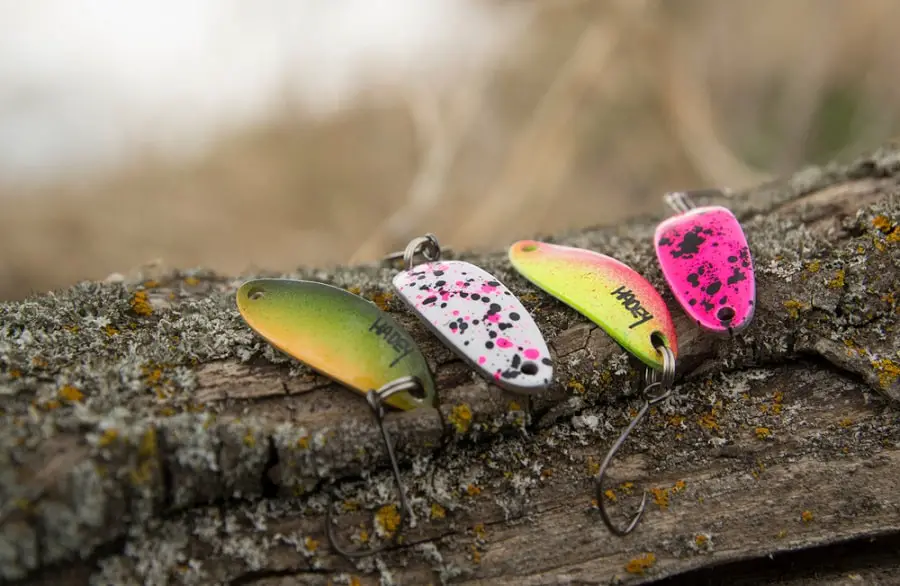
Some anglers and guides swear that spoon fishing for salmon can be the most effective method for aggressive salmon running up the river to spawn.
Even when salmon go off the bait bite, well-presented spoons will often continue to work for me since I know that spoons can trigger an instinctual strike response for salmon that have been feeding on baitfish for the last three or four years.
Catching salmon with spoons can be even more effective if you understand the key concepts that other guides and I use.
Key Takeaways
- Spoon Types: Some spoons just work better in rivers, and some are better when casting the piers and from the beaches.
- Color and Size: The color and size of my spoons will change based on the river conditions and clarity, the size of the salmon, and the salmon’s activity level.
- Set-up: I ensure I am using the most effective line and leader setup for spoons and the size of the salmon.
- Presentation: This is the key to catching salmon know what speed to retrieve, the right depth, where to cast, and how to cover the water more effectively to increase hook-ups
- Triggering Strikes: I will tell you how to trigger more strikes even with the salmon spoons you are currently using.
- Conditions: When I guide salmon with spoons, the methods I use will depend on the river conditions, the depth, clarity, current speed, and activity level of the salmon.
Why Do Salmon Hit Spoons?
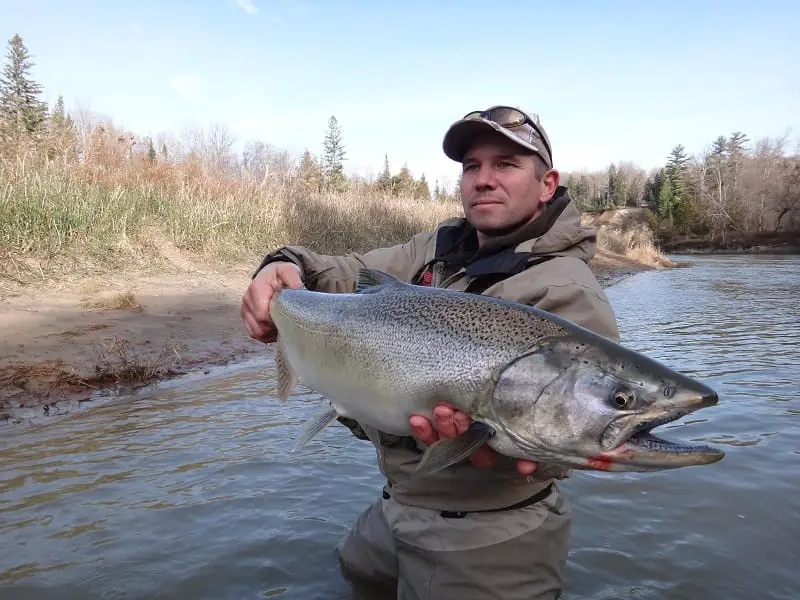
When salmon return to rivers for spawning, they are not there to feed. Instead, they are driven by a primal urge to reproduce and secure the survival of their species. However, salmon are aggressive and territorial as they move up the river and when they are on the spawning grounds.
Because of this, they will often bite anything that poses a threat, or that gets into their territory, this included a good-sized well-placed spoon lure. Salmon will also hit spoon out of instant or habit since 3 years of their life out in the ocean they grab just about anything that looks like baitfish.
The great thing with spoons is that they look and move like baitfish which can trigger a strike response in salmon.
Spoon Fishing Basics
Spoon fishing is a lure fishing method where an angler uses a lure known as a spoon that imitates the fluttering and unpredictable movement of a baitfish.
The right spoons can create a flash and vibration in the water that simulates a distressed fish, triggering the salmon’s predatory instincts. Despite not being in the feeding phase, salmon are provoked to attack the spoons, providing an opportunity for anglers to hook them.
Pro Tip: I reel or retrieve my spoon at a speed that gives the spoon a nice side-to-side wobble. If the spoon is spinning or popping out of the water, I am reeling too fast.
Choosing The Right Spoon For Salmon Fishing
There are two types of spoons available, so choosing the right spoon is important for success.
- Trolling Spoons: These are lightweight spoons designed for trolling only. These do not cast well and they do not work well in current. These should be avoided in rivers.
- Casting Spoons: Casting spoons are heavier, cast farther, sink faster, and have a nice wobble. They also stay down and work well in moving current. These are the best spoons for salmon.
Get some good casting spoons in the 3 to 5 inches length. This length is close to the size of the prevalent baitfish in the river and a large enough target to get the attention of the salmon.
A general rule is to use larger spoons in turbid or high-flow conditions and smaller ones in clear water or when fishing for nervous fish that are holding in pools.
What Color Spoons For Salmon In Rivers?
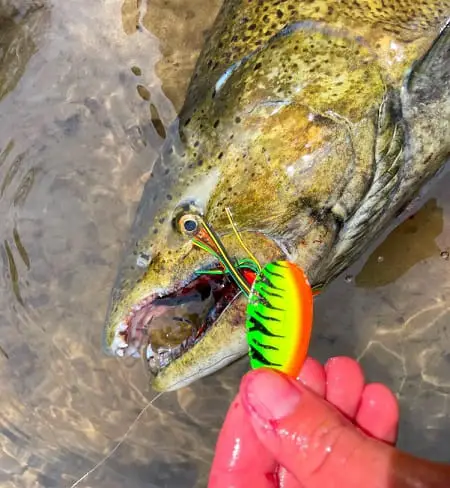
The color of the spoon can also influence the salmon to bite.
Silver, gold, brass, copper or bright-colored spoons with reflective surfaces are often the most effective, as they can create a flash that can be seen from a distance.
At times and under the right conditions, black spoons or black/silver can be very effective.
My most effective salmon spoon color for salmon fishing in rivers are chartreuse, Chartreuse/Silver, Silver, Silver/Orange, Green/Silver, and Blue/Silver.
The Best Spoons For Salmon Fishing
Salmon fishing with spoons is a lot more effective when I am using the proven effective spoons that work well for catching salmon fishing in rivers. These include:
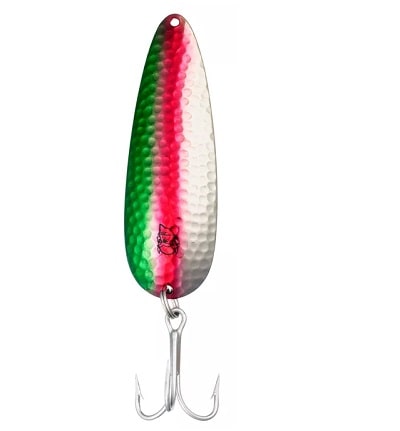
- Little Cleos: The 1.25-ounce 3-inch size is great for big water and long casts.
- Mepps Cyclops: 3.5 inches in various colors, great for all retrieve methods
- Krocodile Spoon: The 3.5-inch size is the best. This is my most effective spoon for salmon.
- Eppinger Dardevle: The 1 oz, 3 5/8 inch spoon is one of my go-to spoons in the lower river for aggressive salmon. This is a very highly rated spoon.
- Thomas Speedy Shiner Spoon: A good 4-inch spoon that works well in rivers for salmon.
Three Techniques For Spoon Fishing For Salmon
Method #1. The most common spoon fishing technique involves casting the spoon into the river, allowing it to sink, and then retrieving it straight in with a slow retrieve.
Method #2. This is also fairly common and works best in faster currents. Cast across and slightly downriver and allow the current to swing the lure across the pool without any reeling in at all. This ‘swing’ technique carries the spoon downstream and across as it sinks.
Method #3. With this method, I will cast the lure out and across the river, allowing it to sink to the bottom. I then lift the rod tip from waist high to a few feet over my head and then lower the rod and repeat. This creates a jigging up and down motion, causing the spoon to flutter like an injured baitfish, which can really drive the salmon crazy.
The jigging method is beneficial in specific areas where salmon are known to congregate, such as below rapids or behind large obstacles in the river, and in pocket water.
Getting The Right Depth
The ideal depth for a spoon is two to three feet over the salmon’s head.
In very clear water, five or six feet over their head might also work. The key is to keep the lure over their heads since they prefer to feed upwards.
I also believe the closer I can get my spoon to the salmon, the more the spoon will aggravate them and trigger a bite. I have seen this with my own eyes. After multiple passes, the salmon finally grab the spoon when it’s very close to them.
Fishing The Spoon High
With methods one and two, I can start reeling as soon as the lure hits the water to keep the lure high in the water. Sometimes the spoon will only be a foot or two below the surface, which is fine in shallow water, clear water, or if the salmon are feeding high.
The faster the retrieval the higher the spoon will be.
Fishing The Spoon Deep
To get depth with a spoon, I will cast straight across or slightly upriver and let the spoon sink before I start my retrieve. The longer I wait the deeper the spoon will go.
The spoon will often start to rise as I start to reel in. However, the slower the retrieve, the deeper the spoon will stay.
If I bump the bottom, I know that I am likely too deep, so I will lift the rod tip abruptly about four to six feet, which should lift the spoon four to six feet higher. If I keep the rod tip elevated, it will keep the spoon higher.
Often, the salmon will be close to the bottom, but sometimes they will be suspended a few feet or more off the bottom, when they are not on the bottom it can be more difficult to catch them.
However, see my guide tip below for covering the water and fishing different levels of the water column.
What Direction Is Best To Cast A Spoon
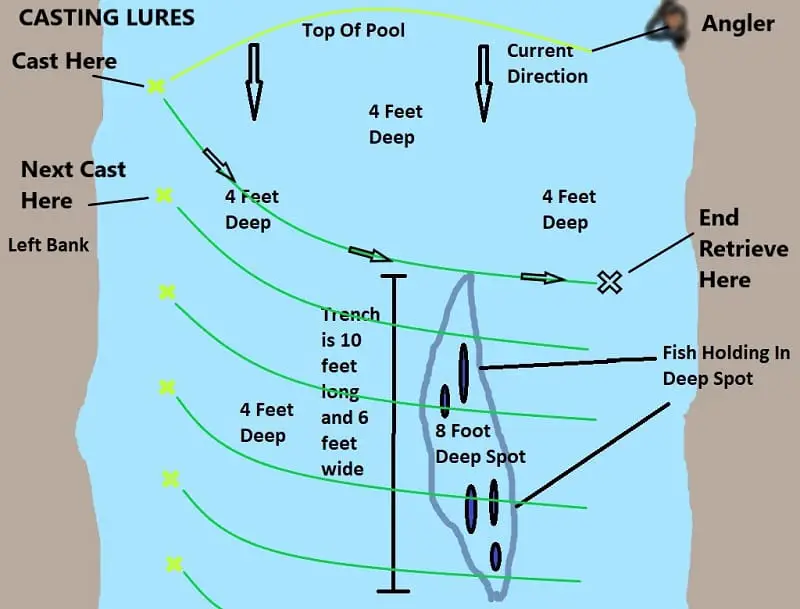
I have found that it is always best to cast my spoon and other lures straight across the river or across and slightly downriver. I discuss this in more detail on my page about Fishing Salmon With Lures.
Some anglers say they prefer to cast upriver and retrieve the spoon downriver and that this works better for them.
In my opinion, the only reason this works is casting upriver makes the lure go deeper and changes the action of the lure. Basically, they are finally able to get the lure deep enough.
A lure coming straight down the river is much harder for the salmon to grab, and it’s unnatural for a baitfish to come straight at them, so I don’t fish this way unless it’s a deep slow pool.
My experience shows that a sideways retrieve is best because a lure fluttering broadside to the fish triggers a better strike response, and a lure moving sideways past them (opposed to straight at them) is a much easier and enticing target.
How To Cover The Water Effectively When Fishing Spoons For Salmon
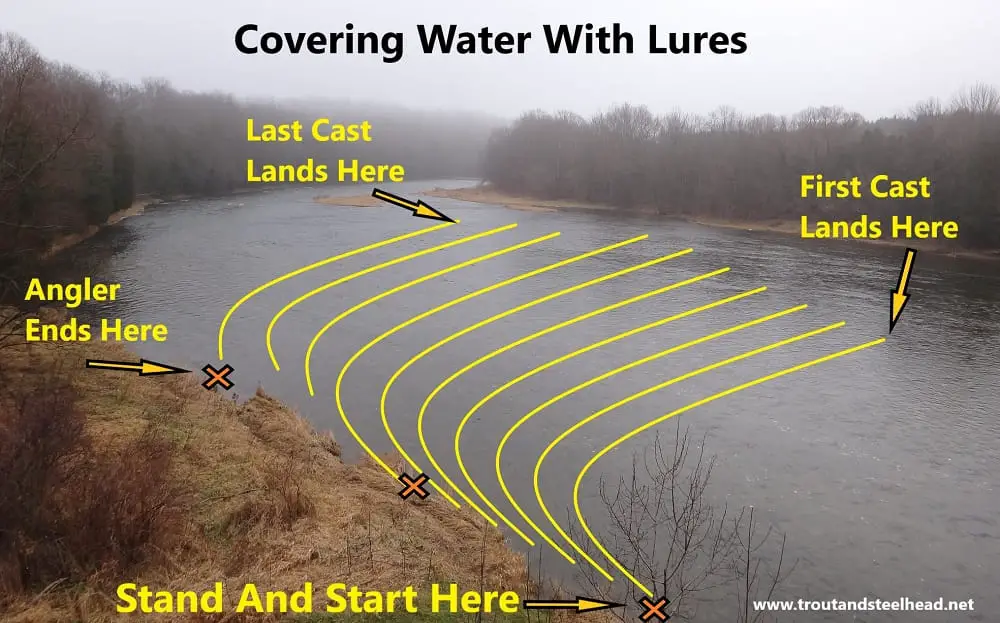
I am very meticulous about how I and my clients cover the water. I have seen anglers fan cast or cast randomly and aimlessly, and this always results in fewer salmon.
Instead, because the salmon are facing upriver, I cover the water from the very top of the spot to the very bottom of the spot in 3 to 5-foot increments.
What this does is it COVERS ALL or most of the river, and it gets my spoon in front of the most salmon. This method of covering the water keeps the spoon in front of the salmon while each consecutive cast slowly moves the lure down towards more salmon.
Covering All Levels Of The Water Column With A Spoon
Using the above method of fishing the top of the spot down, something that works well for me is casting two to three times in the same spot. I do this to determine where in the water column the salmon are holding. Let me explain.
- First Cast: with the first cast, I start reeling immediately to cover the top part of the water column.
- Second Cast: With the second cast, I will allow the lure to sink 4 to 6 feet and start my retrieve. This will cover the middle or lower part of the water column.
- Third Cast: If I haven’t hit a fish or the bottom on the first two casts, I’ll let my lure sink for longer or even sink to the bottom before I start reeling it in. Once it hits the bottom, I’ll lift the rod tip 3 to 6 feet in hopes of keeping the spoon 3 to 6 feet off the bottom.
Once I feel confident that I have covered all levels of the water column, I will move downriver 3 to 6 feet and repeat.
I pay close attention to which level of the water column the fish are at so I can eliminate the high or low casts further down the pool or in the next spot.
Understanding River Conditions
I will often change my methods based on the river conditions. These river conditions include:
- Depth
- Speed or velocity of the current
- Water clarity
- Structure – rocks and logs
- Width
Clear Water Salmon Fishing With Spoons
In clear water, I will run my lure six feet away from the salmon because when it is very clear the salmon might move six up or six feet sideways feet to grab a lure. Spreading my casts out further means I can still be productive, but I can cover more water faster than if i was to fish each cast three feet apart.
Silver flashy spoons still work, but so do dark or black-colored spoons in clear water.
Faster retrieves can also work in clear water, as long as you get the right action from the spoon.
The downside to clear water, especially in shallow clear water, is that the salmon can be nervous and not willing to bite. I’ve seen salmon spooked by the splash of a spoon or when the spoon gets close to them. This usually occurs in low water when they are holding.
If the salmon are spooked, smaller and less flashy spoons can work best when cast far away from the salmon and then pulled past them. I will move the spoon slower, and make sure I stay out of sight.
Guide Tip: When fishing spooked or nervous salmon, do not land the spoon on top of them.
Spoon Fishing In Dirty Water
When salmon fishing with spoons in dirtier water I may need to get the spoon within a foot or two of the salmon.
- I will slow the spoon down as slow as possible.
- I will use a straight retrieve.
- I will use larger lures.
- I will use bright lures.
When the water is dirtier, I focus my efforts on areas that concentrate the salmon, like below rapids, or deep corner pools.
Fast Water Vs. Slow Water
In faster water, the best presentation is the swing method which allows the spoon to move as slowly as possible. Reeling the line in fast water can cause the lure to spin or blow out and can make the spoon too fast for the fish to see or grab.
In slow water, a slow to medium-speed retrieve is best. The Jig-type retreive is also good. The swing method does not work well in slower water.
Tight Lines,
Graham
